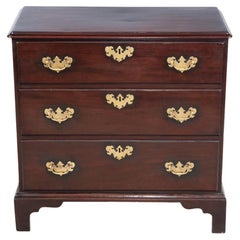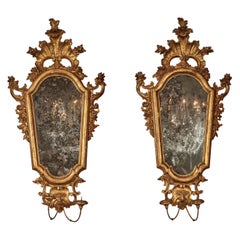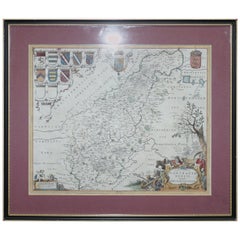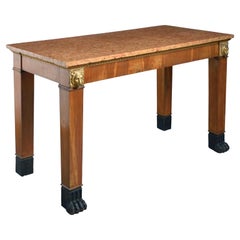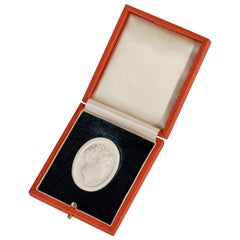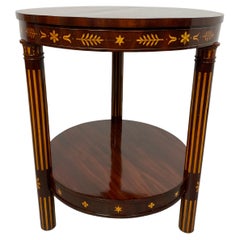Early 1800s Furniture
to
354
1,089
583
1,710
340
115
76
65
33
21
16
14
11
6
3
2
1
1
1
40,663
135,093
550,585
284,604
85,817
261,200
125,626
12,781
5,597
18,720
22,935
19,637
54,288
72,386
61,233
21,708
9,278
707
509
426
193
145
1,048
456
351
251
129
1,710
1,710
1,710
12
10
7
6
6
Period: Early 1800s
George III Bachelor's Chest
Located in Dublin 8, IE
A very fine George III three-drawer bachelor's chest. This piece sits on simple ogee bracket feet and the drawers are complete with brass pulls and e...
Category
Irish George III Antique Early 1800s Furniture
Materials
Brass
$11,516
Gilded Florentine Mirrors with Candle Holders
Located in Los Angeles, CA
Pair of carved, gessoed and gilded framed mirrors. Original mirror with age appropriate spotting and loss of silvering to plates. Gilded tole and wood candleholders. From the area of...
Category
Italian Baroque Antique Early 1800s Furniture
Materials
Wool, Mirror
$18,000 / set
Double Sided Northamptonshire 1645 Hand Colored Antique Print Map Rare Find
Located in West Sussex, Pulborough
We are delighted to this lovely antique Atlas page map of Northamptonshire printed in 1645 Amsterdam Staffordiensis Comitatvs Vulgo
I have three of th...
Category
English Georgian Antique Early 1800s Furniture
Materials
Paper
$427 Sale Price
30% Off
Tuscan Parcel-Gilt Fruitwood Side Table
Located in London, GB
A Tuscan parcel-gilt fruitwood side table, circa 1800.
With original Rosso di Verona marble top. Original decoration.
Category
Antique Early 1800s Furniture
Materials
Marble
White Vitreous Paste Cameo of Emma, Lady Hamilton, Attributed William Tassie
Located in Lymington, Hampshire
A white vitreous paste cameo of Emma, Lady Hamilton, attributed to William Tassie after Filipo Rega, of oval form depicting Emma facing right with her hair in a Grecian style, Englis...
Category
English Antique Early 1800s Furniture
Materials
Vitrolite
Inlaid empire side table circa 1800
Located in Banská Štiavnica, SK
Inlaid empire side table circa 1800 professionally stained and repolished.
Category
Austrian Empire Antique Early 1800s Furniture
Materials
Wood
Georgian Card Table Mahogany Games Tables, 1880
Located in Potters Bar, GB
- Georgian style card table Circa 1880 with cabriole legs terminating on ball and claw feet
- Felt base top with recesses for counters and a fine carved border
- Elegant table that...
Category
Antique Early 1800s Furniture
Materials
Mahogany
Faux Marbled, Venetian Commode
Located in Los Angeles, CA
A striking, c. 1800 hand-carved, painted, and parcel gilt Venetian commode with three, sinuously paneled drawers. The whole in faux verde and Siena ma...
Category
Italian Antique Early 1800s Furniture
Materials
Wood
C19th Century Swedish long case clock with gilded decoration and original paint
Located in London, GB
Wonderful early C19th Swedish long case clock from kougsta in the Jamtland region in an area of natural beauty of central Sweden.
The painted face is numbered simply and framed with ...
Category
Swedish Gustavian Antique Early 1800s Furniture
Materials
Giltwood
Elegantly Hand Carved, Northern Italian Divan
Located in Los Angeles, CA
Elegant, hand carved, circa 1800, walnut divan from the Piedmont region of Northern Italy, featuring pierced, flared side rails and fluted legs. Relief carved apron is filled with fl...
Category
Italian Antique Early 1800s Furniture
Materials
Walnut
Rose and Blue Khotan Fragment Rug, Early 19th Century
Located in San Francisco, CA
Khotan is an oasis city on the old Silk Road in what is now the Xinjiang Uyghur Autonomous Region of western China. Geographically and culturally closer to Central Asia than to Beiji...
Category
East Turkestani Antique Early 1800s Furniture
Materials
Wool
$4,750 Sale Price
26% Off
Baltic Commode, Circa 1800
Located in New York, NY
This mahogany commode has the fluted rails and canted corners typical of case furniture made along the coasts of the Baltic and North Seas around 1800. More difficult to pinpoint, however, is the exact place of its making, since this geographical region stretches from Germany to Russia, and north from Poland to Scandinavia. That said, a strikingly similar, if slightly plainer commode in a private German collection bears an old paper label that identifies it as having been made in the city of Altona. It also bears the seal of King Christian VII of Denmark who reigned until 1808. At the time, Altona was in the independent Duchy of Schleswig-Holstein, located between Denmark and Prussia. Both nations tried to annex the Duchy, and in 1848 it was ceded to Prussia, which became part of Germany in 1871.
A North Sea port, Altona was a member of the Hanseatic League, an association of seaports that was established in the 14th century to foster trade and police the high seas. Around 1800, the aforementioned King Christian of Denmark, who was also the Duke of Schleswig-Holstein, allowed Jews to freely settle in Altona to increase the tax base. This allowed them to conduct business in neighboring Hamburg, a larger financial hub that maintained quotas. The prosperous Jewish families of Altona built villas there, and decorated them with furnishings that were made locally and imported. Many of those makers owned copies of furniture-pattern books, which were widely disseminated among these seaports, accounting for the difficulty in determining if a piece was made in Altona, Stockholm, or St. Petersburg.
We can’t trace our commode to a Danish king or a known Altona merchant, but we can link it to the New World empire builders...
Category
German Neoclassical Antique Early 1800s Furniture
Materials
Brass
$20,000
Very Rare George III Butter Spade Made in London in 1800 by Richard Crossley
Located in London, GB
The butter spade is of an unusually large size, the largest we have offered over the years. The spade is modelled in the Old English pattern and the triangular blade is unusually pie...
Category
English Antique Early 1800s Furniture
Pair of Antique 19th Candle Stand
Located in Tokyo, Tokyo
It will be two sets of prices.
Antique candle stand.
The paint of gold remaining with shabby texture
It brings out an atmosphere unique to anti...
Category
French Art Nouveau Antique Early 1800s Furniture
Materials
Wood
$458 / set
French Trompe L'oeil Drawing Circa 1800
Located in New York, NY
This trompe l'oeil drawing depicts the artist's tools -- a black and a red crayon, and a folding steel ruler that was painted with silver pigments, which have blackened with age. They're shown on a sheaf of papers that include a medieval manuscript page, a musical score, and a group of prints.
The unifying theme is the artistic patronage of the Medici, the Grand Dukes of Tuscany, who intermarried with the Habsburgs, who were the Holy Roman Emperors.
Among the papers are prints by Stefano Della Bella, the Florentine artist who worked for the Medici. They depict a negro page with a horse, and portraits of Lorenzo Lippi...
Category
French Empire Antique Early 1800s Furniture
Materials
Paint, Paper
Spode Double Handled Sugar Bowl and Cover
Located in Long Island City, NY
Spode double handled sugar bowl and cover. Oval-shaped porcelain body, gilt with diamond and vine motifs, the base impressed with an “S” and numbered “6...
Category
English George III Antique Early 1800s Furniture
Materials
Porcelain
George III Satinwood Four Division Canterbury
Located in Lymington, Hampshire
A George III satinwood four division Canterbury, of rectangular form with concave dividers and a handle, the frieze with a single drawer and painted with flowers, on the original bra...
Category
English Antique Early 1800s Furniture
Materials
Satinwood
Iberian Mirror
Located in New York, NY
The so-called Bilbao mirrors were made circa 1800 in Portugal and Spain and named after the city where many were crafted. On our shores they’re often mis...
Category
Spanish Neoclassical Antique Early 1800s Furniture
Materials
Mirror, Walnut
$8,000
Atico dipinto olio su tavola raffigurazione di vergine maria, IXX SECOLO
Located in Milano, MI
Atico dipinto olio su tavola raffigurazione di vergine maria - IXX SECOLO.
Category
Italian Antique Early 1800s Furniture
Materials
Wood
Early 19th Century George III Marble-Top Inlaid Mahogany Table
Located in Dublin 8, IE
Early 19th century George III marble-top inlaid mahogany table, with stone mosaic depicting two birds in a tree, above turned central pillar on tri...
Category
Irish George III Antique Early 1800s Furniture
Materials
Marble
Early 19th Century, Italian, Serpentine Commode
Located in Los Angeles, CA
Elegant, three-drawer, serpentine, inlaid commode featuring a series of parquetry medallions. The whole atop ormolu capped feet.
Category
Italian Antique Early 1800s Furniture
Materials
Bronze
Neoclassical Late Georgian Fire Grate
Located in London, GB
A fine brass and cast iron fire grate, in the George III style. The high shaped back with a central cartouche depicts a double headed eagle and shield, held by a man and a woman. The...
Category
English Neoclassical Antique Early 1800s Furniture
Materials
Brass, Iron
George III Oval Mahogany and King Wood Banded Pembroke Table
Located in Lymington, Hampshire
George III oval mahogany and king wood banded Pembroke table of lovely color. The centre panel is banded in kingwood as are the two flaps.
The whole raised on square tapering leg...
Category
English Antique Early 1800s Furniture
Materials
Kingwood, Mahogany
Fine George III Patch Box Made in Birmingham in 1801 by Joseph Taylor
Located in London, GB
The patch box is of an unusually large oval form, with a pull off cover. The cover is decorated with an outer prick dot and arrow head border, around a set of contemporary script ini...
Category
English Antique Early 1800s Furniture
Pair of Vases in Rouge Griotte Marble, France, Late 1800s
Located in Milano, IT
Pair of Rouge Griotte marble vases mounted on bronze patinated metal. Decorations with vegetable and zoomorphic motifs; feral-shaped feet.
Category
French Other Antique Early 1800s Furniture
Materials
Griotte Marble
Spanish Walnut Table, circa 1800
Located in Lincolnshire, GB
A wonderful Spanish walnut table of large scale with a thick one plank top of superb colour. The table retains the fantastic original metal work and could stand well as either a side...
Category
Spanish Antique Early 1800s Furniture
Materials
Walnut
Very Rare Georgian Facet Cut Wine Glass with Octagonal Foot c1800
Located in Tunbridge Wells, GB
Heading : 18th century facet cut stem wine glass
Period : George III
Date : c1800
Origin : England
Colour : Clear
Bowl : An ogee bowl engraved with OXO swags. Further facet cuts to t...
Category
British George III Antique Early 1800s Furniture
Materials
Blown Glass
Etching of the Guildhall London
Located in London, GB
Designed & engraved for Lamberts History of London by E.Shirt sc.
Published by M.Jones No 1 Paternoster Row.
Dated April 30th 1805.
In a modern frame, probably a book plate.
Nice ...
Category
English Antique Early 1800s Furniture
Materials
Glass, Hardwood, Paper
1800 Empire Nast Porcelain Griffins Masks Roses Flowers Garlands France Vase
Located in Munich, DE
This very high quality French vase in caramel hue with guilding is most probably made by the Nast Porcelain Manufacture ( 1754 - 1817 ). It's handles ar...
Category
French Empire Antique Early 1800s Furniture
Materials
Porcelain
1806 Printed Linen Kerchief Glorifying George Washington, Germantown, Penn
Located in York County, PA
EXTRAORDINARILY EARLY (1806) PRINTED LINEN KERCHIEF GLORIFYING GEORGE WASHINGTON, PRINT WORKS, GERMANTOWN, PENNSYLVANIA
Printed in blue ink on coarse, white linen, this patriotic kerchief shows a standing portrait of George Washington, above which is a swag valance and the words “The Effect of Principle, Behold the Man”. The portrait is based on a mezzotint after Gilbert Stuart’s very famous painting of Washington in his later years, most often referred to as the Landsdowne portrait. Stuart painted three versions of it in oil on canvas, one of which was completed in 1796 for a wealthy merchant by the name of William Constable, who commissioned the work for Alexander Hamilton.
The kerchief is interesting because it is both American-made and documented. This is exceptionally unusual for any printed textile of the 19th century or prior and the earlier the time period the more unlikely an object is to be identified. This kerchief and a companion piece entitled “The Love of Truth Mark the Boy” (also glorifying Washington, through the fabled story of the cherry tree), were made circa 1806 by Germantown Print Works in Germantown, Pennsylvania.
To the left of Washington's image is a portion of his infamous farewell address to his troops at the end of the Revolutionary War. To the right is a short excerpt from his eulogy. Below these are three images. In the center is a square-rigged tall ship with “Commercial Union” above it, flanked by the American eagle on the left and the British lion on the right. It is reasonable to assume that the textile may have been produced in demonstration of the maker's desire, and/or that of others, to advance trade with England. Commercial printers were very influential in early America, as they possessed the means by which to disseminate information.
This kerchief and its companion piece are documented in Threads of History, Americana Recorded on Cloth, 1775 - the Present, by Herbert Ridgeway Collins (1979, Smithsonian Press), p. 63, items 38 & 39.* The two pieces pictured are in the collection of Cornell University, but the Collins text also cites an uncut pair to be present in the collection of the Western Reserve Historical Society, Cleveland, OH. The name "Germantown Print Works" is printed on the Western Reserve examples. Another example of the textile in question is documented in "Running for President, The Candidates and Their Images, 1789-1896" by Schlesinger, Israel, and Frendt, (1994, Simon & Schuster), p. 15.
I have seen three different color variations of this textile, including sepia, mulberry red, and blue. This particular example has a hand-sewn binding along the top, lower, and left edges.
Mounting: The textile was mounted and framed within our own conservation department, which is led by expert staff. We take great care in the mounting and preservation of flags and have framed thousands of examples.
The gilded molding has a rippled profile and dates to the period between 1825 and 1850.The background is 100% cotton twill, black in color. The glazing is U.V. protective plexiglass. Feel free to contact us for more details.
Condition: There is an all-over golden oxidation of the white fabric and there is very minor staining. There are tiny tack holes in each corner and there are minor nicks around the perimeter.
* Collins relates that Germantown Printworks was operated by the Hewsons. In doing so he cites one of Worthington Chauncey Ford's books on George Washington, but it isn't clear which one (there are many) and no page numbers are given. John Hewson was an Englishman who came to America and opened his printing business on the advice of Benjamin Franklin. He was one of the first “calico printers” and is the earliest documented to have advertised printed kerchiefs. His ads for bandanas appear as early as June 20th, 1774. He is suspected of having produced the very first American kerchief that pictured an American president, which is documented in Collins as item 1 on page 48. Linda Eaton, curator at Winterthur, in 2012, is currently doing in depth research on the three printers of fabrics that were operating in Germantown in early America. She discovered that the owner and/or operator of Germantown Print Works, while not currently known, was not John Hewson. This information is not yet published. She also noted that Winterthur possessed examples of the two George Washington textiles...
Category
American Antique Early 1800s Furniture
Materials
Cotton
